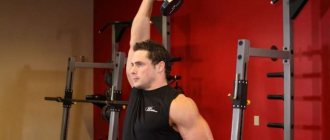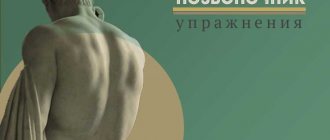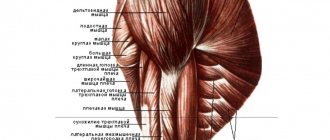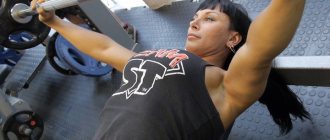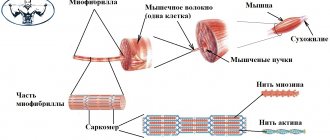The head pull-up exercise is usually used to diversify the usual exercises on the horizontal bar. In addition, this is a great opportunity to put stress on your back. If you already know how to properly exercise on the horizontal bar, then it would be right to add this exercise to the general list.
Before you begin the exercise, you need to familiarize yourself with the general rules so as not to harm yourself in the future. In this article we will look at which muscles are involved during such a procedure and what effect will be achieved by pulling up behind the head with a wide grip.
Benefits and disadvantages of pull-ups behind your back
Any pull-up involves the latissimus dorsi, but pull-ups behind the head, due to the change in body position and greater amplitude when moving upward, distribute the load on the rhomboid and teres muscles, which creates proportionately massive muscles and promotes broadening of the back.
Thanks to the pronounced (compared to other pull-up options) static load and pause at the top point of the amplitude, the target muscles acquire clearer outlines and relief.
You can't do without minuses.
- This exercise is not suitable for those athletes who have individual anatomical characteristics of the body.
- Also, you should adhere to the technique of performing the exercise, if you ignore it, the effect of the exercise will be minimal.
head
HEAD , s, vin. head, plural heads, heads, heads, w.
1. Part of the human (or animal) body, consisting of the skull and face (in the case of an animal, the muzzle); in invertebrates, an anterior, relatively isolated part of the body with sensory organs and a mouth opening. hang one's head, lower one's head (also translated: to become despondent; colloquial). With your head held high (also translated: proudly). Bow (bare) your head in front of someone. (also translated: to express one’s respect, admiration; highly).
2. Skull box. Wounded in the head and face. Put it on your head and on your head. Hold your head and your head. Grab your head and your head (also translated: to be horrified; colloquial). G. hurts. G. splits, cracks (about a severe headache; collapsing). Tablets for the head (for pain in the head; decomposition).
3. Mind, reason. A man with a head (smart; colloquial). Someone completely without a head. (completely stupid; colloquial). Nothing comes to anyone's mind. (can’t think about anything or concentrate). There's something wrong with someone's head. (not quite normal; colloquial). Nobody can come out of my head. (does not leave the thought of someone; colloquial). Out of my head, out of my head (completely forgot; colloquial).
4. Man as a carrier of what ideas, views, abilities, properties. Bright, smart city. Hot city.
5. m. (vin. head). In Tsarist Russia: the name of certain military, administrative and elected command positions, as well as the persons occupying these positions. Streletsky city volost city city city council.
6. m. (vin. head). Leader, chief (colloquial). To the whole matter Mr. someone. Mr. himself
7. (vin. head and head), what. The front of something. moving and elongated. G. infantry column. G. comets. The carriage at the head of the train. Go in the head (ahead of a chain of people, a detachment; also translated: to lead some kind of business, undertaking).
8. Food product in the shape of a ball or cone. G. sugar. G. cheese.
9. A unit for counting livestock and animals. A herd of 200 heads.
• Head or head above someone about someone who is much superior to someone. mentally.
remove the head from someone (colloquial) 1) put someone on. in a difficult, hopeless situation. You took my head off with your refusal; 2) strictly punish, punish. For this oversight your head will be taken off.
My head hurts about what (simple) something. cares, worries. Let the bosses have a headache about this matter.
In the heads (colloquial) at the head of the head.
First of all (colloquial) first of all.
Everyone's head is (colloquial) about the most important, the most important. Bread is the head of everything.
To betray someone with one's head (obsolete) treacherously to betray (in 3 meanings).
To give oneself away without wanting to, to give oneself away, to show oneself from the negative side.
go over your head (colloquially). The goods are over your head.
Lather someone's head (simple) give a severe reprimand, scold.
Be responsible for someone with your head (colloquial) to bear full responsibility for someone.
To rack your brains over something (colloquial) to try to understand or come up with something. difficult, complex.
To lose one's head (colloquial) to become completely confused.
To hang one's head (colloquial) to become despondent, to despair.
Don't spare your head, don't spare your life.
On my head (colloquial) on my responsibility, as well as on my misfortune.
On your own head (colloquial) to your own detriment.
To sit on the head of someone (colloquially disapproved) to behave shamelessly.
On whose head to impose (colloquial disapproved) pester or ask for it.
to walk on one's head (colloquial disapproval) to be disgraceful, to be self-willed.
About two heads who (colloquially disapproving) about the one who acts too risky, thoughtlessly and dangerously.
Shame on someone's head about what is shameful for someone.
To blame from a sore head to a healthy one (colloquial disapproval) to shift the blame from the guilty to the innocent.
To immerse yourself (immerse yourself) in something entirely, to completely surrender to something. (some kind of business, activity).
From the head (take, receive) (colloquial) from one, from each of the participants, from the brother. It costs a ruble per head.
From (from) head to toe or from head to toe (colloquial) completely, completely. A gentleman from head to toe. Get wet, smear yourself from head to toe.
Through whose head (to act) bypassing someone, without informing those directly interested.
| decrease head , and, g. (to 1, 2, 3 and 8 values). They won't pat you on the head for anything. (they will not praise, condemn or punish; colloquial irony.).
| caress. little head , and (to 1 and 4 values).
| adj. head , aya, oe (to 1, 2 and 7 meanings). G. dress. G. brain. Head cars (front).
Source: Explanatory Dictionary of Ozhegov and Shvedova on Gufo.me
Meanings in other dictionaries
- head - noun, g., used. max. often (not) what? heads, what? head, (see) what? head, what? head, about what? about the head; pl. What? heads, (no) what? heads, what? heads, (I see) what? heads, what? heads, about what? about heads... Dmitriev's Explanatory Dictionary
- head - Common Slavic word of unclear origin. Probably related to the noun nodule. Krylov's etymological dictionary
- head - 1. The upper part of the human body. About the size, shape of the head, forehead, neck, characteristic physical feature. Antique, large, majestic, huge, long, long-necked, graceful, square, wedge-shaped, colossal, short-necked, head-shaped, round, large... Dictionary of Russian language epithets
- head - • Majestic (Turgenev). • Proud (Barykova, Muizhel). • Kudlastaya (Terpigorev). • Kudlataya (Veresaev). • Curly (Strazhev). • Shaggy (Sologub). • Lobastaya (L. Tolstoy). • Mastitis (Fet). • Pobednaya (Nekrasov). • Stubborn (Sergeev-Tsensky). Dictionary of literary epithets
- head - Name of military and administrative positions in Russia XVI-XVII centuries. (streltsy city, convoy city, written city, etc.) and elected city and class positions in the 18th - early 20th centuries. (urban city, volost city, craft city). Large legal dictionary
- head - The front or upper part of the body. The head skeleton is the skull in which the brain is located. The senses (vision, hearing, smell, taste) and food-grasping organs are concentrated on the head. In some primitive animals (eg. Biology. Modern Encyclopedia
- head - HEAD, heads, vin. head, plural heads, heads, heads, women. 1. The upper part of the human or animal body, consisting of the skull and face. Turn your head. Ushakov's Explanatory Dictionary
- head - see >> disease, pinnacle, tycoon, head, main, unit, leader, smart see also -> the wind moves in the head, cheerful head, soar one's head, take one's head, take one's head, take one's head , hang over your head, enter, into your head... Abramov’s Dictionary of Synonyms
- head - spelling head1, -s, vin. head, plural heads, heads, heads (part of the body, etc.) head2, -s, vin. -u, pl. heads, heads, heads, m. (official) Lopatin's Spelling Dictionary
- head - head of wines. n. head, Ukrainian head, old glory head, bolg. head, Serbohorv. head, slovenian glâva, Czech, Slavic hláva, Polish gɫowa, v.-luzh. hɫowa, n.-luzh. gɫowa. Regarding the original for emphasis, see Fortunatov, BB 22, 171; Thorbjornsson 1, 77 et seq. Etymological Dictionary of Max Vasmer
- head - 1. head, heads, heads, heads, head, heads, head, heads, head, head, heads, head, heads 2. head, heads, heads, heads, head, heads, head, heads, head, head , heads, head, heads Zaliznyak Grammar Dictionary
- Head - (caput) - the anterior section of the body of insects, consisting of several segments fused together into one whole. The number of segments that make up ... Encyclopedic Dictionary of Brockhaus and Efron
- Head - Head, chapter I. The word “head” is often found in the Bible both in its literal and figurative meaning: 1) as a sign of sadness, G. was lowered to the ground, sprinkled with dust (Job 2:12) or ashes (see. Brockhaus Biblical Encyclopedia
- head - HEAD, -s, w. A cap. Without a head - with a bare head. Explanatory dictionary of Russian argot
- head - s, vin. head, plural heads, -lov, -am, w. 1. The upper part of the human body, the upper or front part of the animal's body, containing the brain. My head hurts. Shake your head. Hanging your head. Small academic dictionary
- head - head I f. 1. The upper part of the human body, the front or upper part of the body of a vertebrate animal, consisting of the cranium and face in a human or the muzzle in an animal. || decomposition Hair on this part of the human body (usually about hairstyle). 2. transfer Explanatory Dictionary by Efremova
- GOLOVA - GOLOVA - the name of military and administrative positions in Russia in the 16th and 17th centuries. (streltsy head, convoy head, written head, etc.) and elected city and class positions in the 18th - early. 20th centuries (city mayor, volost mayor, crafts mayor). Large encyclopedic dictionary
- head - TOP - BOTTOM Upper - lower reaches (see) upper - lower (see) upper - lower (see) top - bottom (see) up - down (see) top - bottom (see) up - down (see) up - down (see) above - below (see) above - below (see) Top of the house - bottom of the house. Dictionary of antonyms of the Russian language
- Head - I Head Head injuries are, unfortunately, quite common. These may include bruises and soft tissue wounds, traumatic brain injury (traumatic brain injury), and injuries to the face and jaw. Bruises. Medical encyclopedia
- head - HEAD w. head, a part of the body consisting of a skull with a brain, muscles, integument with hair, etc. head, brain. For the difference between head and chapter, see chapter. Dahl's Explanatory Dictionary
- head - Head/a. Morphemic-spelling dictionary
- head - HEAD (Capul), anatomical. part of the body delimited from the neck by a conventional transverse plane drawn along the posterior edges of the branches of the lower jaw. The bone basis of G. is the skull. G. is divided into facial and cranial regions. Veterinary encyclopedic dictionary
- head - Cinema Dictionary of thieves' jargon
- Head - I The head is the anterior (or upper, in particular in humans) section of the body of mobile, bilaterally symmetrical animals, separated from the body. Great Soviet Encyclopedia
- HEAD - Name military and adm. positions in Russia 16-17 centuries. Military positions: hundredth G. - beginning. hundreds in the noble militia; Streltsky G. (from the 2nd half of the 17th century - colonel) - early. Streltsy order (regiment); Cossack G.; Pushkarsky G. (G. at the outfit) - beginning. mountains Soviet historical encyclopedia
- head - (caput), the anterior or upper section of the body of mobile, bilaterally symmetrical animals, separate from the body. The organs of orientation in space and the organs of grasping food are concentrated on the brain. Biological encyclopedic dictionary
- head - HEAD -s, vin. head; pl. heads, -lov, -am; and. 1. The upper part of the human body, the upper or anterior part of the body of a vertebrate animal, consisting of the cranium and face in a human (or snout in an animal). Raise, lower, turn your head. Kuznetsov's Explanatory Dictionary
- head - Obsesslav. The root is the same (with a change o/e) as in the nodule, Old Russian. nodule “turtle, nodule.” Original *golva (cf. cognate lit. galva “head”) > head as a result of the development of full consonance. The word is an expressive secondary name for the head. Shansky Etymological Dictionary
- head - (head - main) Wed. (Me esse) hujus rei caput. The head of this matter. Terent. Mikhelson's Phraseological Dictionary
- head - First of all (colloquial) - first of all, first of all. ► First of all, you need to learn your lessons. Throw something out of your head (colloquial) - forget, leave the thought of something. ► Get this nonsense out of your head! Wash, or (more often) soap someone's hair (colloquial fam.) - transl. Volkova's Phraseological Dictionary
- head - noun, number of synonyms... Dictionary of synonyms of the Russian language
- Blog
- Jerzy Lec
- Contacts
- Terms of use
© 2005—2020 Gufo.me
What muscles work in pull-ups?
- The main load falls on the latissimus, round and rhomboid muscles of the back.
- Also involved are the trapezius muscles, posterior deltoids, biceps, forearms and serratus muscles.
- The stabilizers during the movement will be the spinal extensors and abdominal muscles.
In a "Fuck You" costume
A memorable story happened before the “fight of the century” with Floyd Mayweather in 2016. Then Conor McGregor decided to try himself in professional boxing for a guaranteed fee of $30 million. Mayweather Jr. received about 100 million.
Conor showed up to the boxers' first press conference in a suit that was completely covered in obscene language directed at his opponent. When the Irishman was asked what this all meant, he calmly replied: “My suit says: “Fuck you!”,” and looked in Floyd’s direction.
That fight, of course, was won by Floyd Mayweather. This happened in the tenth round by technical knockout.
How the Mayweather-McGregor fight went. Help More details
Technique for performing pull-ups with a wide grip behind the head
This is a difficult exercise. It’s easy to do, but getting the desired effect from head pull-ups is actually not easy. This is because the exercise is based on a specific movement and requires concentration, stretching and experience from the athlete to perform it. Otherwise, only the biceps will work.
The starting position is the same as for regular pull-ups. Consider a wide grip:
- The athlete should grab the bar with a wide grip - hands should be wider than shoulder-width apart.
- The head should be moved slightly forward. This will allow you to straighten your back as much as possible. There is no need to throw your head back or tilt your head too much.
- While exhaling, pull yourself up with the back of your head behind the bar. During this movement you need to bring your shoulder blades together. At the top point of the amplitude, the shoulder blades should be completely retracted. The trapezoid should be kept static.
- The peak point of amplitude will be reached when the shoulder blades close completely, and a distance of a couple of centimeters remains from the crossbar to the back of the head.
- When you reach the top point, you should pause and slowly lower down.
- At the bottom point, you should straighten up completely, allow the latissimus dorsi muscles to stretch properly and repeat the movement.
Who should not do these exercises?
If you have ever had diseases associated with the cervical spine or shoulder joint, then we do not advise you to resort to this approach, since it is in these areas that serious stress occurs.
Do not try to immediately take the widest possible grip, as this again risks injury. First, try a grip slightly wider than shoulder width, and then monitor your own sensations and adjust your movements if necessary.
About the exhibit
The mummified head, which is kept in the ethnography fund of the State Darwin Museum, has been seen only by museum employees over the past hundred years. There are two versions of how it ended up in the collections: according to one of the museum legends, it was acquired by Alexander Fedorovich Kots, who collected various rarities. According to the second version, the exhibit came to the museum from a certain merchant Khomyakov, who owned a valuable collection of natural science exhibits before the revolution. Among them were such unique things as the skeleton of the dodo (Dodo bird), a stuffed great auk, a collection of rare books and stuffed extinct passenger pigeons. Unfortunately, data on some exhibits acquired before the foundation of the museum, when official documentation began, has not been preserved.
But the dried head was preserved, but until recently it was sealed. The museum staff knew that it was possible to get the head out of the box, but the box was very heavy and old - at least three men would be needed to carefully and correctly unscrew the ancient screws without breaking the threads. And yet they decided to do it - the “opening” took place in 2020. The goal was to verify the authenticity of the head. After all, it is known that at the beginning of the 20th century, due to the popularity of such exhibits, counterfeits were mass-produced in South America.
Tsantsa, stored in the Darwin Museum / © Anton Usanov / Press service of Mosgortur
Dmitry Miloserdov: “It wasn’t exactly an examination, but I specifically studied one very serious work by the American ethnographer and anthropologist Matthew William Stirling, “Historical and ethnographic material about the Jivaro Indians” of 1933 (expedition 1928-1930) - the largest scientific work, dedicated to the Jivaro Indians and, in particular, to the production of tsants. He lived with the Jivaro Indians for three years and watched how all this was done. I analyzed its description and came to the conclusion that our specimen is real. This is supported by a certain method of suturing the eyelids and the correct placement of the seams on the scalp.”
Load by muscle group
The load is indicated on a 10-point scale (the total load is summed up)
| Latissimus muscles | 9 (high) |
| Upper back | 7 (high) |
| Forearms | 5 (average) |
| Rear delta | 4 (average) |
| Biceps | 3 (average) |
| Total load/exercise type | 28 (high) / basic global |
In Efremova's dictionary
Accent: head
- and. The upper part of the human body, the front or upper part of the body of a vertebrate animal, consisting of the cranium and face in a human or the snout in an animal.
- trans. coll. Hair on this part of the human body (usually about hairstyle).
- Leader, senior in position, role; chapter.
Looking for a "recipe"
Europeans - these were the Spanish conquerors - first became acquainted with the Jivaro in the 16th century. They were the first to note that the tribe makes miniature human heads. In Spanish manuscripts one can find isolated evidence of how this happened. One of the companions of the famous conquistador Francisco Pizarro in 1527 describes this practice: “They preserve the heads of the dead by embalming them. After removing the bones of the skull through the neck, the face, which retains its shape, they impregnate with agents that preserve the flesh or skin so that it does not rot, and the cartilage of the nose remains intact, and the hair, as well as the eyebrows and eyelashes, remain attached to the flesh.
After numerous procedures and drying out, the heads became very small, like those of a newborn child. After they have shrunk the head, they keep it in small chests that they have in the temple, and it lies there for many years without rotting. According to the Indians, this may last two or three centuries. Of course it's amazing and no one has ever seen it. And it seemed to us, when we first saw it, that these were the heads of a race of dwarfs who lived in the country until we learned the truth about it.”
One of the explorers of Peru in 1543 wrote this: “In some temples, especially in the cities which they call Pasao, men and children were crucified on the walls, the bodies or skin mummified so well that they did not smell bad. We also saw the heads of Indians, which were reduced by special decoctions to the size of a fist.”
The Spanish traveler and diplomat Don García de Silva Figueroa, who explored the jungles of Brazil in 1665, wrote the following: “The first process they perform with the heads of killed enemies is boiling them. Then, having removed the skin from the head and face, they stuff it with straw and dry it in the smoke, thus making a reduced head.”
Jivaro family / ©Illustration from the book “Historical and ethnographic material about the Jivaro Indians” by M. W. Stirling, 1933
In 1862 in Paris, a sample of a reduced human head was presented to the anthropological society and a report was made on it and the methods of its manufacture. Describing the specimen, Dr Mize said: “A simple inspection of this head shows that the Indians were very skilled in the art of taxidermy - they removed all the skin in one piece from the face, skull and upper part of the neck. Then they dried it with such great skill that it shrank evenly, and the head became the size of the head of a newborn child, while preserving even the small features of the face.”
Dmitry Miloserdov: “At the end of Mayz’s presentation, members of the society expressed opinions about the preservation procedure, and at that time these opinions, of course, were erroneous. And Mize himself was mistaken, because he believed that the head was dried simply by removing a piece of skin. One of the scientists believed that if there were cuts in the skin, they would definitely be visible after mummification, another - that drying occurs naturally in hot sand.” In general, at the beginning of the second half of the 19th century, the technology for making tsants in Europe was still unknown.
Sundial
If you have completed all the previous Alans, we move on to a new level of difficulty. Sit on the floor with your legs bent in front of you. Raise your left leg and push it with your left hand as far back as possible behind you until you can eventually place it on your left shoulder. When the discomfort becomes less, grab your left leg with your right hand, which was previously the support, and continue to push back. Now the support is the left hand.
Continue to perform asanas regularly until you can straighten your legs, arms and back. Don't forget to switch legs!
How to start classes correctly
It is recommended to perform the exercises in the first part of the workout in the gym. To begin with, you need to choose the right weight (block weight) and number of repetitions. For this, it is better for beginners to contact an instructor.
Weight is determined by the level of physical fitness and the goals of the bodybuilder (to lose weight, build muscle mass, to “dry” the body). Beginners first need to work out the technique correctly, so it is better to start training with minimal weight.
It is necessary to start with 10 repetitions of 2 - 3 sets with weights of 25 - 30 kg for men and 15 - 20 kg for women . It is advisable for athletes with little experience to do 12 times for 4 approaches, for athletes with experience - 15 times for 4 approaches.
The main thing when performing an exercise is to adhere to the quality of the exercises, and not their quantity. To “dry”, gradually increase the weight or number of repetitions.
Before each session, be sure to do a warm-up (cardio exercise on an exercise bike, squats, bends, exercises with dumbbells) to warm up your muscles and prepare them for a safe and effective workout. At the end of the session, you need to relax the working muscles by stretching.
Before training, it is recommended to drink a glass of water (green tea), and during training, drink a little every 15-20 minutes. To increase muscle mass, you need to eat protein (powdered protein drinks, lean poultry or fish, egg whites) and carbohydrate foods (rice, oatmeal, wholemeal bread, freshly squeezed fruit juices diluted with water) in the first 20 minutes after training.
Almost eliminate fat from the diet. It is not recommended to eat food 1-2 hours before training.
Classic lat pulldown
Main stages of correct execution:
- Correct placement in the machine. First, adjust the roller that secures the legs (knees) so that the weight does not pull the body upward. Place your hips tightly under the bolsters, and press your feet to the floor at knee level. Place the pelvis on the seat so that the upper block with the bar is above your head.
- Grab the handle of the bar with your hands. Having taken the correct position on the machine, as you exhale, pull the bar down, moving it behind your head. The narrower the grip, the more the biceps are worked (which in this case is not desirable), and the range of movements increases. On the contrary, as the grip increases, the load on the back increases and the amplitude decreases. It is optimal to choose a medium grip. There are scars on the handle on the right and left, you need to grab it so that your little finger is at the beginning of the scar - this is approximately an average grip. When bending your elbows at the lowest point at an angle of 90°, your forearms should be perpendicular to the floor and parallel to each other. The training cable is placed in a vertical position.
- When performing the exercise, fix your body exactly in a vertical position and do not slouch, tilt your head slightly forward, but look straight. In this case, the forearms move along the body, the shoulder blades are brought together. Pull the bar only by working your back muscles, not your arms! If during the movement the shoulders and forearms tense, and not the back (latissimus, rhomboid and lower trapezius muscles), then the execution is incorrect. If, despite the correct technique, the back is not being worked out, it is necessary to reduce the weight.
- You need to pull the bar until you lightly touch the back of your head. Then pause at the bottom point for a few seconds and straighten your elbows at the top point and inhale, but do not completely relax the shoulder girdle. You should not stretch your back and shoulders too much; this can lead to sprains and injuries. At the end of the workout, when the elbows are extended at the top point, take a series of inhalations and exhalations.
For a harmonious physique and athletic torso, it is recommended to systematically perform lat pulldowns 2-3 times a week.
Features of the technology:
- If, due to poor mobility of the shoulder joints, it is impossible to perform this exercise without slouching, it is better to abandon it.
- When moving your arms down, you need to lean forward slightly and bring your shoulder blades together.
- You need to pull the bar to the middle of the back of your head. To reduce excess load on the forearms, you can secure your hands to the bar with straps.
- Keep your head straight and look forward. The back is straight.
In the Dictionary of Synonyms
head, bowler, top, tycoon, head, chief, leader, smart; unit, one; disease; roof, skull, skull, tower, birdhouse, scalp, piggy bank, crown, crock, cast iron, kumpol, booth, bulldozer, intellect, little head, talent, slate, little crown, reasoner, elder, vat, tile, melon, little head, kumekalka, tambourine, heads, attic, understanding, hat, jug, boss, computer, bashkaten, brains, mozgan, little head, pot, spire, headset, sage, house, head, mental abilities, senior, samovar, solver, cerebellum, helmet, charabanc , smart head, clueless, bone, pumpkin, bright mind, head, golden head, wise guy, smart girl, quick-witted, quick-witted, chban, kukunder, turnip, charabanc, reason, teapot, boss, dromged, baklushka, bright head, protoma, thinking abilities, kolban, head of cabbage, reason, a storehouse of wisdom, a man of great intelligence, a man of far-reaching intelligence, a chicken coop, understanding, a far-reaching mind


